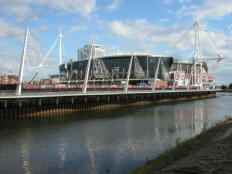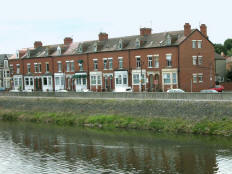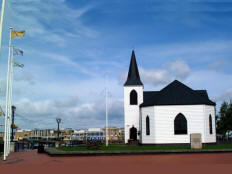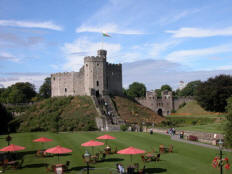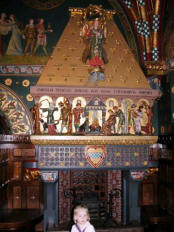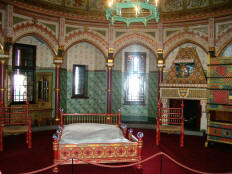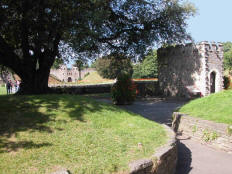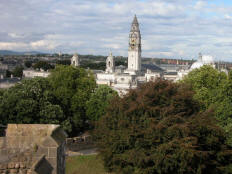Part IV - Page 15 16 16a 17 18 19 Go to: Part I Part II Part III
Thursday, 1 September. The Arosfa had won an award for having the best Welsh breakfast, and it was well deserved. One offering was new to us and surprisingly good: Celtic laver bread, made of seaweed rolled in oats and fried in olive oil. But we were used to having only one big breakfast a week at home, and day after day of these huge breakfasts was getting to us. It was raining at 9:30 when we left Aberaeron, and the weather fluctuated between rain and sun almost all the way to Cardiff.
The roads were only marginally better than those in Snowdonia, and there were more villages. There were the real bottlenecks because parking was not prohibited on the main road through them. That usually meant there was only one lane open, yet there were cars coming from both directions. So traffic from one direction simply had to stop and wait, either for a break in traffic or a kind soul who would allow cars headed the other way to go.
CARDIFF Cardiff has a relatively short history as a city. Although prehistoric peoples lived in the area and the Romans had a fort here, the present city can be traced to 1091, soon after the Norman invasion, when work began on Cardiff Castle. A small English settlement grew up around the Castle, surrounded by hostile Welsh territory. The settlement barely hung on as the Castle decayed. By the 18th century it was a sleepy backwater of 1,500 people. With the Industrial Revolution, however, Cardiff thrived as it became the biggest coal-exporting port in the world. It finally became a city in 1905 and the capital of Wales in 1955.
After doing a little unpacking, we walked a couple blocks to Cardiff Castle. We planned to tour the Castle, but when we saw a city tour trolley parked just outside the gate, we decided to take that tour first. The tour started at 2:00 so we still had enough time to find the Tourist Office and get a map and some brochures.
From there we drove through the older sections of the city, including several of the main shopping streets. We passed the Edwardian New Theater (1905 but recently refurbished), and the old Queen Street Railroad Station (1840 but much modified). We drove through the Irish Quarter and by St. David’s Catholic Cathedral (1836 but rebuilt after WWII). There was a great deal of modern construction going on, often in the shells of older buildings. In an area known as Bute Terrace, we saw a huge, modern, high-rise apartment complex (Altolusso House) that preserved the facade of a much smaller old Victorian building (New College.) as its entrance.
Cardiff Bay seemed to be undergoing the most significant development with the creation of the Millennium Waterfront. It looked like a good place to wander and take in the scenery. Since our tour was of the hop-off, hop-on variety, we decided to get off at the Mermaid Quay stop. We were dropped off in front of the Millennium Centre, site of the ultramodern new performing arts theater. Just in front of the theater stood the Waterfall, a tall, thick column with water cascading down from the top. A few steps toward the Bay was the old, red brick Pierpoint Building which now houses the Welsh National Assembly's Information Centre. It was 2:45 and we hadn’t had lunch (Remember that huge Welsh breakfast!), so we stopped for an ice cream at a restaurant that jutted out over the water, giving us a great view of the entire Millennium Waterfront area.
Back on the bus, we drove by Techniquest, a Science Discovery Center with numerous exhibitions and interactive activities. Nearby was the old Norwegian Church (1868), moved to its present location in 1990), now an art gallery. We continued past the old coal shipping area, the Church of Wales, Brian’s Brewery, and the Old Post Office. We saw old buildings built from a mix of stones from all over the world. These were ballast stones brought back by the hundreds of ships that carried Welsh coal around the globe. Finally we passed Millennium Stadium, right across the river from our B&B. We were dropped off at Cardiff Castle about 3:00 and went inside for a tour. Both the history and the architecture of the Castle present an unusual mix of uses and styles. The Romans apparently had four successive forts on the site (55-400 A.D.). (The later Roman walls were rediscovered in 1889 and partially rebuilt. These restored walls can be viewed by visitors.) Nearly seven centuries later (1081), the Normans built a new castle on the site. The ensuing centuries saw periods of neglect, modifications, demolition, and additions under various owners. The present castle began to take shape after the first Marquess of Bute acquired the property in 1776, culminating in a major remodeling by his grandson in the late 1800s. The Castle was turned over to the City of Cardiff in 1947.
The guided tour concentrated on the palatial interior rooms. Afterwards we explored the grounds on our own. I climbed to the top of the tall tower of the keep for the great view. Jane made it to the next level below.
By this time, it was after 5:00. We walked back to Austin’s B&B and rested for an hour before going out to dinner. It was cold and windy, and Jane didn’t feel like walking very far anyway, so we went to the restaurant of the Holiday Inn just across the river. We were back in our room at 8:30 and did some packing.
Part IV - Page 15 16 16a 17 18 19 Go to: Part I Part II Part III |




